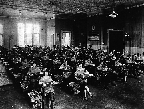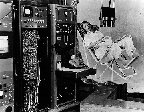 |
Science and Technology |
Argonne HistoryBiology: Living Organisms and Their RhythmsAt Argonne National Laboratory, research in the biological sciences has always been an interdisciplinary effort. Teams of nuclear and molecular physicists and chemists work with life scientists to study the causes and potential cures of cancer and the effects of radiation on biological systems. Scientists at the Metallurgical Laboratory, and then at Argonne, pioneered the field of radiation research. Historical highlights covered here include heat-loving bacteria, circadian rhythm research that led to the Argonne Anti-Jet-Lag Diet, pioneering studies of humans exposed to radiation on the job, and early research on the causes and origins of cancer.
Circadian RhythmsIn August 1954, a three-part spectrograph -- carbon arc light source, reflector mirror and diffracting grating -- was designed at Argonne. It was the largest and most versatile of its type in the country. On it, light was separated into various wavelengths to produce a full band of color from the invisible ultraviolet to the invisible infrared. Data on the interaction of radiant energy with protoplasm was now possible. The spectrograph was an important research tool for Argonne's innovative studies on circadian rhythms, the clock-like cycles in cells that regulate basic life functions. In 1953, Argonne biologists demonstrated for the first time the existence of a biological clock in single protozoan cells. They also showed that this clock could be unset and reset by light. This breakthrough discovery led to the 1982 design and development of Argonne's Anti-Jet-Lag Diet and regimen to ease the effects of trans-continental travel and shiftwork rotation. The Argonne Anti-Jet-Lag Diet continues to be widely used by frequent fliers, and a new web site provides thousands of travelers a year with free information about this helpful traveler's aid. Creating a New Area of ResearchOne unusually important phenomenon at the Met Lab was radiation -- never before had so many people been assembled to work with radioactive materials. By mid-1942, an all-out research effort was underway on the effects of radiation on animals -- and the term "health physics" was coined. Argonne continued that trail-blazing work. Early studies with transuranic elements, fission products and other radioisotopes led to international radiation standards for the protection of humans exposed to these new materials and to the current methods for removing radioactive materials from the body. It is now rare to see human beings with substantial amounts of radioactivity in their bodies. In earlier decades, however, significant numbers of people ingested radium on the job.
Among the groups of people studied by Argonne were painters of luminous watch dials who used their lips to point radium-laden brushes. They experienced an unusually high rate of bone cancer. These and many other people with body burdens from radiation exposure received before radiation dangers were understood were enlisted in Argonne's pioneering studies to determine the maximum permissible levels of radioactive substances in the human body. Argonne's first facility for measuring radioactivity in humans was an "iron room" where during the 1950s the nation's most sensitive and accurate radiation assays of humans were conducted. These tests allowed scientists to determine the amounts, locations and identities of extremely small quantities of radioactive materials in the body -- as little as one-billionth of a gram of radium. Similar facilities were later used throughout the world.
Attempts to modify the effects of radiation led to development of the first successful protective agent against x-rays, to techniques for removing radioactive metals from the body, and to in-depth studies of tissue transplants and the immune system. Cell transformation systems were used to study the carcinogenic processes following exposure to either promoter or inhibitory chemical agents. A chemo-prevention research program was developed to reduce cancer risk to patients receiving radiation treatments. Argonne also took a lead role in photobiology, especially in lethal and mutagenic effects of near-ultraviolet radiation in bacteria. Argonne scientists were the first to conduct in-depth examinations of the genetic effects of exposure to near-ultraviolet radiation. The findings were critical to assessing effects of exposure to the sun and the risks of exposure to artificial light used in medicine and industry. Finding Causes and Origins of CancerThe search for a bone-cancer virus was undertaken by a team of biologists which, in 1965, found a filterable agent that produced cancerous tumors in mice. This discovery added a new tumor to the lexicon of known virus-produced malignancies, as well as a strong suggestion of a viral origin in all cancers. In 1975, the team isolated two bone-tumor viruses further strengthening the hypothesis that viruses may play a role in the formation of cancerous bone tumors. Meanwhile, other cancer studies were achieving pace-setting advances. In 1962, Argonne biologists discovered that white corpuscles in the blood stream represent only a minute portion of those manufactured in the bone marrow, an important clue to understanding leukemia. In 1969, two related abnormal blood and urinary proteins from a bone-cancer patient were isolated and crystallized. It was the first time an immunoglobin had been crystallized. Characterized as an important breakthrough, the first immunoglobin crystallization was part of Argonne research that greatly increased understanding of the human immune response at the molecular level. Argonne biologists were also the first to demonstrate an aminothiol-mediated gene expression and its effects on DNA synthesis. |
|
||||


